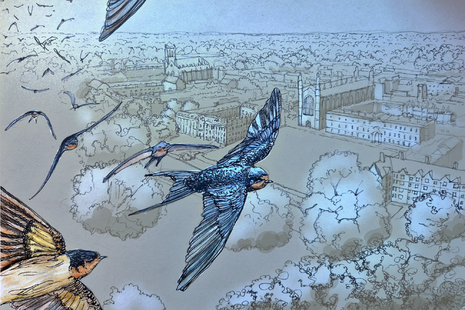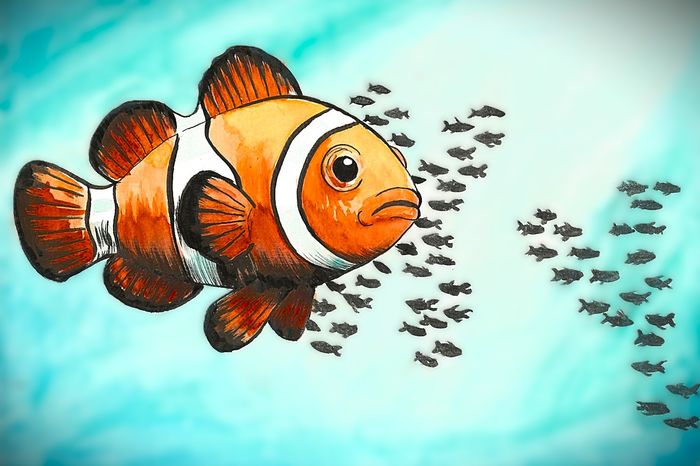As the swallow flies: could understanding birds’ migratory patterns be the key to quantum computing?
Milena Aarts looks into how birds use the Earth’s magnetic field to migrate south, and why it’s the subject of key research

With autumn underway, you may notice that in Cambridge the summer songs of swallows and swifts are being replaced by the melodious sounds of redwings and fieldfares. 20% of the world’s bird population is migratory and fly to warmer countries in the winter. The migration of birds has puzzled humans for millennia; Aristotle even proposed that redstarts morphed into robins for the winter. Of course, we now know this is not the case, but how do birds travel thousands of miles from the UK to Africa and vice versa every year?
It is unlikely to come as a surprise that birds use sight for navigation, but it is not only geographical landmarks, such as rivers, that are important. Essentially identical to how sailors have done for millennia, birds use the rotation of the stars around the North Star to direct them north or south.
However, the exact migration route birds take is genetically coded – birds whose parents have differently encoded migration routes will often take an intermediate direction. Research suggests that the first migration cycle is very important as birds often use the same route for the rest of their lives. To retrace their steps each year, they use their sense of smell to recognise places they have been before, and in addition to this, birds also use a sense that we do not possess: ‘magnetoreception’. This is defined as the ability to sense the Earth’s magnetic field and use it for orientation.
“Migration routes are genetic – birds whose parents have different paths will take an intermediate direction”
How birds detect magnetic fields is sort of a mystery, but it is gradually becoming clearer. There are two main competing hypotheses. One theory is that their tissues contain crystals of magnetite, a magnetic iron mineral, which physically aligns with the Earth’s magnetic field. However, this requires the crystals to be both large enough to physically rotate to align with the Earth’s weak magnetic field, but also small enough to overcome frictional resistance experienced when moving in tissue.
A far more promising hypothesis was proposed in 1978 by Klaus Schulten, which suggests that magnetoreception has a quantum nature.
To explain Schulten’s theory, it is important to understand that covalent chemical bonds (bonds where two non-metals share electrons) can break in two ways: heterolytically or homolytically. When bonds break heterolytically, one atom in the bond receives both shared electrons forming the bond and, when bonds break homolytically, each atom receives an electron.
The latter leaves both atoms with an unpaired electron, which are known as free radicals. Unpaired electrons have a property called ‘spin’ which is a vector with both direction and magnitude. The formation of two free radicals at the same time during a chemical reaction can result in the unpaired electrons having either parallel spins (that is, going in the same direction) or having antiparallel spins (going in opposite directions). If a free radical pair is formed with antiparallel spins, the internal magnetic field may cause the electrons to switch between the parallel and antiparallel states millions of times per second.
“Researchers are studying bird migration to develop quantum computers”
This is where birds come in – this switching is also influenced externally by the Earth’s weak magnetic field, providing an explanation for how they may be able to sense it: they may possess a molecule that is sensitive to the magnetic field by forming radical pairs which behave as microscopic magnets. It is believed that magnetoreception is light-dependent, leading scientists to search for a suitable molecule in the eye. Currently, the most likely contender is a protein called cryptochrome 4. Because of this, researchers are looking to study bird migration to develop quantum computers.
Another question which scientists are keen to develop an answer to is how birds survive on minimal sleep. In many songbirds, ‘micronaps’ appear to be sufficient to prevent any compromise to physiological function. If you are wondering whether you too can adopt these ‘no sleep’ strategies, the answer is, unfortunately, no, but you would not be the only one interested in doing so. The U.S. Defense Advanced Research Projects Agency (DARPA) has invested money into a program that analyses the neural circuits of migrating birds in an effort to create a ‘no-sleep soldier’.
Unfortunately, man-made structures and light pollution may be affecting bird migration negatively. A 2022 study found that species richness of birds was lower in areas with wind turbines compared to control sites, suggesting that avoidance of infrastructure may affect the distribution pattern of migratory birds. Artificial lighting at night may also be disruptive as it attracts night-migrating birds, often causing them to fly in circles. This behaviour increases likelihood of collision with buildings and exhausts precious energy needed for flight.
So, when you next see a swallow preparing for its long journey ahead to Africa, or a redwing recently arrived from Scandinavia, perhaps you can have greater appreciation for the fact that nature has developed both quantum technology and a way to minimise sleep needed before us. One thing is certain, and that is that researching migratory birds will be fundamental for developing technology in the future.
 News / Gov declares £31m bus investment for Cambridge8 December 2025
News / Gov declares £31m bus investment for Cambridge8 December 2025 News / Pembroke to convert listed office building into accom9 December 2025
News / Pembroke to convert listed office building into accom9 December 2025 Science / Fancy doing research this summer? A guide to getting involved as a student8 December 2025
Science / Fancy doing research this summer? A guide to getting involved as a student8 December 2025 News / Write for Varsity this Lent3 December 2025
News / Write for Varsity this Lent3 December 2025 News / Uni redundancy consultation ‘falls short of legal duties’, unions say6 December 2025
News / Uni redundancy consultation ‘falls short of legal duties’, unions say6 December 2025










